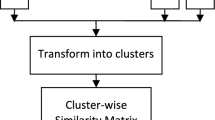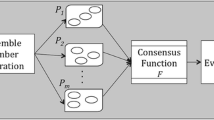Abstract
Clustering ensemble combines several fundamental clusterings with a consensus function to produce the final clustering without gaining access to data features. The quality and diversity of a vast library of base clusterings influence the performance of the consensus function. When a huge library of various clusterings is not available, this function produces results of lower quality than those of the basic clustering. The expansion of diverse clusters in the collection to increase the performance of consensus, especially in cases where there is no access to specific data features or assumptions in the data distribution, has still remained an open problem. The approach proposed in this paper, Clustering Ensemble Extraction, considers the similarity criterion at the cluster level and places the most similar clusters in the same group. Then, it extracts new clusters with the help of the Extracting Clusters Algorithm. Finally, two new consensus functions, namely Cluster-based extracted partitioning algorithm and Meta-cluster extracted algorithm, are defined and then applied to new clusters in order to create a high-quality clustering. The results of the empirical experiments conducted in this study showed that the new consensus function obtained by our proposed method outperformed the methods previously proposed in the literature regarding the clustering quality and efficiency.









Similar content being viewed by others
References
Akbari E et al (2015) Hierarchical cluster ensemble selection. Eng Appl Artif Intell 39:146–156
Alizadeh H, Minaei B, Parvin H (2014) Cluster ensemble selection based on a new cluster stability measure. Intell Data Anal 18:389–408
Alizadeh H, Yousefnezhad M, Minaei B (2015) Wisdom of crowds cluster ensemble. Intell Data Anal 19:485–503
Azimi J, Fern X (2009) Adaptive cluster ensemble selection. In: Proceedings of the 21st international joint conference on artificial intelligence. Morgan Kaufmann Publishers Inc., Pasadena, California, USA, pp 992–997
Bagherinia A et al (2020) Reliability-based fuzzy clustering ensemble. Fuzzy Sets Syst 413:1–28
Bai L et al (2019) An information-theoretical framework for cluster ensemble. IEEE Trans Knowl Data Eng 31:1464–1477
Banerjee A et al (2021) A new method for weighted ensemble clustering and coupled ensemble selection. Connect Sci 33:1–22
Elghazel H, Aussem A (2015) Unsupervised feature selection with ensemble learning. Mach Learn 98(1–2):157–180
Fern XZ, Brodley CE (2004, July) Solving cluster ensemble problems by bipartite graph partitioning. In: Proceedings of the twenty-first international conference on Machine learning, p 36
Fern XZ, Lin W (2008) Cluster ensemble selection. In: Proceedings of the 2008 SIAM international conference on data mining (SDM). Society for Industrial and Applied Mathematics, pp 787–797
Fozieh Asghari P, Saber N, Muhammad Y (2017) Wised semi-supervised cluster ensemble selection: a new framework for selecting and combing multiple partitions based on prior knowledge. J Adv Comput Res 8(1):67–88
Fred A, Jain A (2005) Combining Multiple Clusterings Using Evidence Accumulation. IEEE Trans Pattern Anal Mach Intell 27:835–850
Hadjitodorov ST, Kuncheva LI, Todorova LP (2006) Moderate diversity for better cluster ensembles. Information Fusion 7(3):264–275
Hamidi SS, Akbari E, Motameni H (2019) Consensus clustering algorithm based on the automatic partitioning similarity graph. Data Knowl Eng 124:101754
He Z, Xu X, Deng S (2005) A cluster ensemble method for clustering categorical data. Information Fusion 6(2):143–151
Huang D, Wang C-D, Lai J-H (2018) Locally weighted ensemble clustering. IEEE Trans Cybern 48:1460–1473
Iam-On N et al (2012) A Link-Based Cluster Ensemble Approach for Categorical Data Clustering. IEEE Trans Knowl Data Eng 24(3):413–425
Jia J et al (2011) Bagging-based spectral clustering ensemble selection. Pattern Recogn Lett 32(10):1456–1467
Jing L, Tian K, Huang J (2015) Stratified feature sampling method for ensemble clustering of high dimensional data. Pattern Recogn 48:3688–3702
Karypis G, Kumar V (1998) Multilevel k-way partitioning scheme for irregular graphs. J Parallel Distrib Comput 48(1):96–129
Kuhn HW (1955) The Hungarian method for the assignment problem. Naval Research Logistics Quarterly 2(1–2):83–97
Kuncheva L, Hadjitodorov S (2004) Using diversity in cluster ensembles, vol 2, pp 1214–1219
Li F et al (2018) Cluster’s quality evaluation and selective clustering ensemble. ACM Trans Knowl Discov Data 12:1–27
Li F et al (2019) Clustering ensemble based on sample’s stability. Artif Intell 273:37–55
Li T, Rezaeipanah A, Tag El Din EM (2022) An ensemble agglomerative hierarchical clustering algorithm based on clusters clustering technique and the novel similarity measurement. J King Saud Univ Comput Inf Sci 34(6, Part B):3828–3842
Lourenco A et al (2013) Probabilistic consensus clustering using evidence accumulation. Mach Learn 98:331–357
Ma T et al (2020) Multiple clustering and selecting algorithms with combining strategy for selective clustering ensemble. Soft Comput 24(20):15129–15141
Mahmoudi MR et al (2021) Consensus function based on cluster-wise two level clustering. Artif Intell Rev 54(1):639–665
Minaei B et al (2014) 2.02. Effects of resampling method and adaptation on clustering ensemble efficacy. Artif Intell Rev 41:27–48
Naldi M, Carvalho A, Campello RJGB (2013) Cluster ensemble selection based on relative validity indexes. Data Min Knowl Disc 27:259–289
Parvin H et al (2012) 2.03. A new classifier ensemble methodology based on subspace learning. J Exp Theor Artif Intell 25:1–27
Saidi M et al (2017) Instances selection algorithm by ensemble margin. J Exp Theor Artif Intell 30:1–22
Strehl A, Ghosh J (2002) Cluster Ensembles - A Knowledge Reuse Framework for Combining Multiple Partitions. J Mach Learn Res 3:583–617
Sulaiman NH, Mohamad D (2012) A Jaccard-based similarity measure for soft sets. In: 2012 IEEE symposium on humanities, science and engineering research
Tan P-N, Steinbach M, Kumar V (2016) Introduction to data mining. Pearson Education India
Topchy A, Jain AK, Punch W (2004) A mixture model for clustering ensembles. In: Proceedings of the 2004 SIAM international conference on data mining (SDM). Society for Industrial and Applied Mathematics, pp 379–390
Topchy A, Jain AK, Punch W (2005) Clustering ensembles: models of consensus and weak partitions. IEEE Trans Pattern Anal Mach Intell 27(12):1866–1881
Wang L et al (2022) Markov clustering ensemble. Knowl-Based Syst 251:109196
Yang Y, Chen K (2011) Temporal Data Clustering via Weighted Clustering Ensemble with Different Representations. Knowledge and Data Engineering, IEEE Transactions on 23:307–320
Yang F et al (2017) Cluster ensemble selection with constraints. Neurocomputing 235:59–70
Yousefnezhad M et al (2016) A new selection strategy for selective cluster ensemble based on Diversity and Independency. Eng Appl Artif Intell 56:260–272
Yu Z et al (2015) Adaptive Noise Immune Cluster Ensemble Using Affinity Propagation. IEEE Trans Knowl Data Eng 27(12):3176–3189
Zhao X, Cao F, Liang J (2018) A sequential ensemble clusterings generation algorithm for mixed data. Appl Math Comput 335:264–277
Author information
Authors and Affiliations
Corresponding author
Additional information
Publisher's Note
Springer Nature remains neutral with regard to jurisdictional claims in published maps and institutional affiliations.
Rights and permissions
Springer Nature or its licensor (e.g. a society or other partner) holds exclusive rights to this article under a publishing agreement with the author(s) or other rightsholder(s); author self-archiving of the accepted manuscript version of this article is solely governed by the terms of such publishing agreement and applicable law.
About this article
Cite this article
Sedghi, M., Akbari, E., Motameni, H. et al. Clustering ensemble extraction: a knowledge reuse framework. Adv Data Anal Classif (2024). https://doi.org/10.1007/s11634-024-00588-4
Received:
Revised:
Accepted:
Published:
DOI: https://doi.org/10.1007/s11634-024-00588-4




